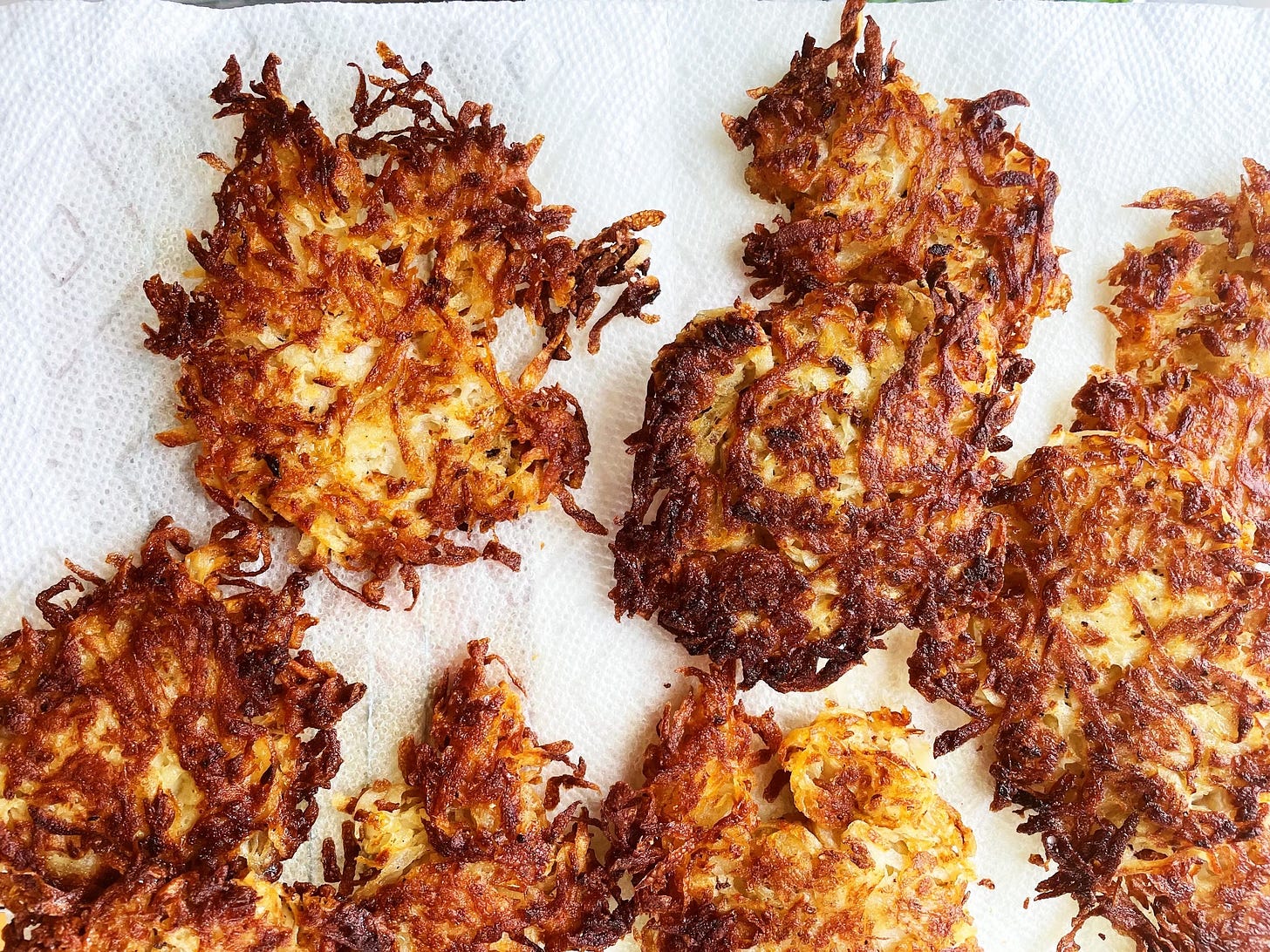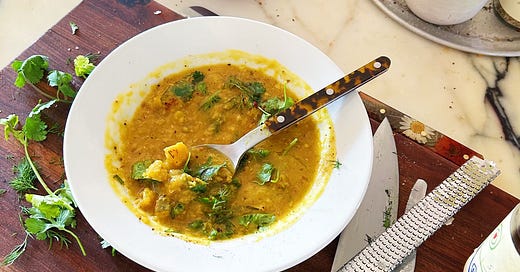Hello and welcome to Home Movies Tuesday! If you’ve found your way over by some miracle but are not yet subscribed, here, let me help you with that:
Latkes, like many varieties of fried potato, are a perfect food. But unlike average varieties of fried potato (french fries are mostly average*), latkes are a special occasion food, to be made with care and eaten on special occasions. Latkes are savory, laced with onion, and fried in schmaltz. Latkes are made delicately in batches with careful attention, eaten almost immediately out of the skillet.
*TLDR; French fries are fine. This is different than me not liking them, they are just not my preferred crispy potato snack (and if it’s French fries vs. onion rings, it’s onion rings every time). I am a shredded hash-brown dipped in Crystal hot sauce. I am a knish sprinkled with seasoned salt. I am a latke served with sour cream and applesauce. [if we are dining at a restaurant together and there are French fries on the menu, I will not order them. If you order them, will I have a few of yours, with or without asking? Depends on how close we are and what style fry (thick-cut, never), but yeah, probably.]
TIPS FOR LATKE SUCCESS
1. Squeeze out all the liquid from the grated potato mixture. All of it. I use my hands, but if you want to use a cheesecloth or other dish towel, that’s cool. Whatever gets you through. When you think you’ve gotten all the liquid out, whisper to yourself: “Moisture is the enemy of the crisp.” Repeat that several times and keep squeezing.
2. Go the distance, locate chicken fat. It imparts unrivaled crispiness and savoriness that can’t otherwise be replicated. I buy a container from my butcher (Paisano’s) and keep it in the freezer. I use it for matzo balls, kugel, and latkes. I also use it to roast chicken, for carrots, inside dumplings, etc. Find it, buy it, use it, freeze it.
3. Make a tester. Like with any pancake, a tester is the canary in the coalmine. Does it need more egg? More salt? More pepper? More breadcrumb? Heat too low? Too high? Now’s your chance to adjust.
4. Accept what a latke is and what it will become with the passing of time. I’ve always struggled with the suggestions that you “keep them warm in the oven,” or “keep them crispy on a wire-rack” or that somehow “oven latkes” will ever be as good as the real deal. For what it’s worth, I prefer to simply surrender to the fact that freshly and delicately fried things are often best served immediately and stop trying to find a solution that always leaves me feeling sad trombone. If you want to do a party with latkes, I do support it— just know they won’t be as crispy as they sit. They’ll be great, maybe even crispy enough (if done properly), but acceptance of reality (not frustration or defeat) is key in pulling off latkes for many.
Click HERE for a printable PDF.
Crispy, Salty Latkes
serves 4-6
The key to crispy latkes lies in a hot skillet with plenty of fat (I like the 50/50 blend of schmaltz/neutral oil) and getting absolutely every ounce of liquid out of those potatoes and onions. When you think you’ve wrung all the water out of the potatoes, keep squeezing. There’s more liquid to give, I promise. And sure, I know the “let the potato starch settle to the bottom of the bowl and use that to bind” trick, but, uh, to paraphrase myself: Yeah, I’m not gonna do that. To make these gluten-free, use GF bread crumbs/matzo meal/ground up matzo boards, or simply use 2 tablespoons potato starch, which you may have on hand if you’re gluten-free?
3 pounds russet potatoes (about 4-6), peeled
1 pound onions (about 3 medium), peeled
kosher salt and freshly ground black pepper
¼ cup dried breadcrumbs, panko or matzo meal (or 2 tablespoons potato starch)
1-2 large eggs
neutral oil, such as canola or grapeseed
schmaltz, a.k.a. chicken fat (optional, but recommended)
sour cream, apple sauce, chives, and salmon or trout roe, for topping (optional, but necessary)
Using the largest holes of a box grater, grate the potatoes and onions into a large bowl. Season with kosher salt, toss and let the mixture sit for 5-10 minutes.
Taking small handfuls of the potato-onion mixture and using your hands, squeeze the liquid out over a colander fitted inside a bowl, then set the wrung-out mixture aside. Continue this process until you’ve squeezed out as much liquid from the whole mixture as you possibly can (and when you think you can’t squeeze anymore, keep squeezing).
Add 1/4 cup fine plain breadcrumbs or matzo meal (or whatever gluten-free substitute starch you’re using) and toss the mixture to combine. Add 1 egg, season with salt and pepper and toss again until well combined (if the mixture looks a little dry, that’s ok, it’ll loosen up as it sits).
Line a rimmed baking sheet (with a wire rack insert, if you like) with paper towels. Heat a large skillet over medium-high heat, and add a thin layer of oil, followed by about the same amount of chicken fat, letting it melt.
Once your oil/schmaltz is hot enough that it starts to shimmer, drop a little bit of latke mixture as your tester. It should start to fry and sizzle immediately (if it doesn’t, let your skillet get a little hotter before proceeding), holding together in an irregular pancake shape (if it falls apart—more hashbrown than latke—then add the second egg to your mixture.
Once your skillet is hot enough, start to fry your latkes. Spoon a bit of the mixture into the pan, taking care not to pack them so they stay light and airy). Fry until deeply golden on the first side, about two minutes, then using a spatula, flip and fry until deeply golden on the second side, another 1 and a half to 2 minutes. Transfer them to the paper towel-lined wire rack as they finish.
Remove any stray pieces, eat them (chefs treat!), and continue to fry.
Top your latkes however your heart desires. For a savory-salty vibe, I like topping with sour cream, salmon roe, chives, and cracked black pepper, and for a sweet-salty vibe, I like topping with sour cream then dipping in apple sauce.
*If you want to keep them warm, say, for a party, I suggest keeping them on a wire rack (no paper towel) in a 375 oven. This will keep them warm and as crisp as possible (just know they’ll never be as crisp as when they come out of the oven). Just don’t leave them in too long or they’ll dry out and become rubbery instead of crispy. A true Shonda.
Classic Apple Sauce
Click HERE for a printable PDF.
1 pound apples (about 3), cored and chopped (I don’t peel my apples because I like texture, but you can if you want)
1/4–1/3 cup sugar
Lemon juice or apple cider vinegar for finishing, if needed
Cinnamon, for finishing (optional)
1. Combine the apples and 1/4 cup sugar with 1 cup water in a medium pot.
2. Simmer on medium until the apples become completely softened and begin to break down. As they soften, use a wooden spoon to smash them to your desired consistency.
3. Remove from heat and season with more sugar if needed, a splash of lemon juice or apple cider vinegar, and cinnamon, if you’d like.





















At the end of your latke video you mentioned you would post your recipe for apple sauce. Will you now?
Hi! I am making these for a party this weekend and wondering the best way to reheat them after I have fried them the night before? I want them to remain crispy and wondering if you all have any tips! Thank you in advance!